The night sky is adorned with countless stars, creating a breathtaking view. From our perspective on Earth, all these celestial bodies appear to be identical. However, the vast cosmos is home to billions of stars, each varying in size and luminosity. Scientists continually make new discoveries, expanding our knowledge of the universe. Among these discoveries are some of the largest stars, which have been extensively studied by astronomers.
Determining the exact size of these massive stars can be challenging, as they may have extended lengths or dust shells. Nevertheless, astronomers use the equatorial radius of the Sun as a standard unit of measurement. The Sun itself is considered a relatively large star, with a radius of 695,500 km.
1 VY Canis Majoris
VY Canis Majoris is an enormous red hypergiant star located in the constellation Canis Major. It is one of the largest known stars in the universe and holds a prominent place in astronomical research.
1 VY Canis Majoris
VY Canis Majoris, situated in the Canis Major constellation, is a colossal red hypergiant star. Known for its immense size, it is regarded as one of the most significant objects of study in the field of astronomy.
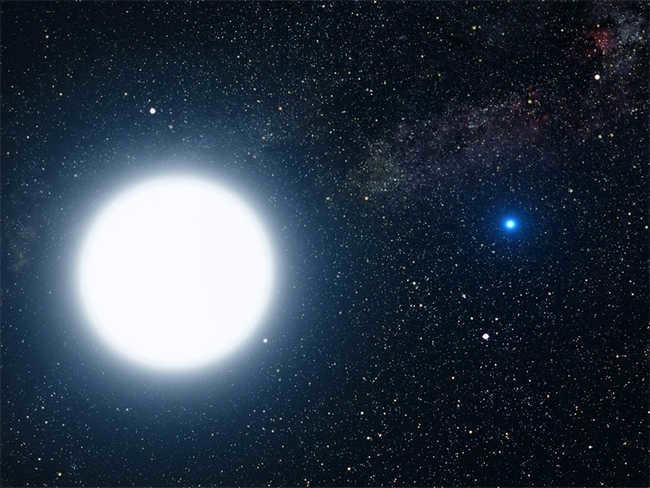
This celestial object located in the constellation of Canis Major is widely regarded as the largest star in the entire Universe. Not only that, it is also acknowledged as the most luminous, outshining our very own celestial luminary by a staggering 500,000 times. Situated some 5,000 light years away from our Solar System, this magnificent entity boasts a radius equivalent to a mind-boggling 1,800 to 2,100 times that of the Sun (as confirmed by scientists in 2005). In terms of diameter, it measures an astonishing 2.5 to 2.9 billion kilometers. It’s truly difficult to fathom the immense size of this star and the sheer brilliance with which it radiates! Furthermore, the star’s mass, estimated to be between 1.5 and 2.5 times that of our Sun, further attests to its extraordinary enormity.
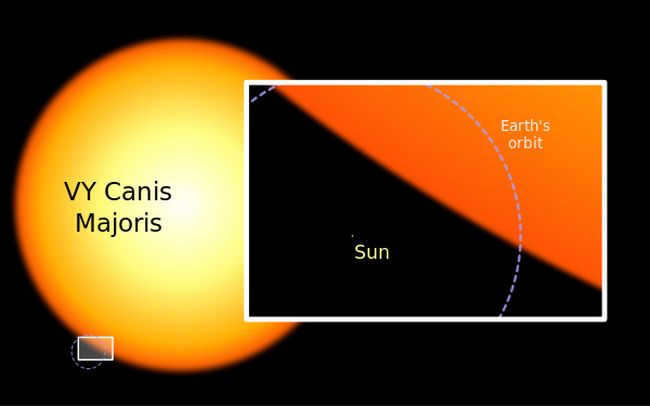
If the Sun were replaced by this enormous celestial object, it would completely fill the entire expanse of our Solar System, extending all the way to Saturn. Traveling around this gigantic star at supersonic speeds, it would take a minimum of 230 years to complete a single orbit. Initial observations of this star date back to 1801, when it was classified as the seventh brightest star. In 1847, scientists discovered that this star has a distinct reddish hue. The hypergiant is surrounded by luminous regions of nebula, which were initially mistaken for separate entities by scientists in the 19th century.
Scientists have observed a gradual decrease in brightness of the object since 1850, similar to other celestial objects. This indicates that the star is undergoing the natural process of aging and depleting its hydrogen reserves. Eventually, it is expected that the star will either transform into a neutron star or collapse into a black hole.
2 WON G64.
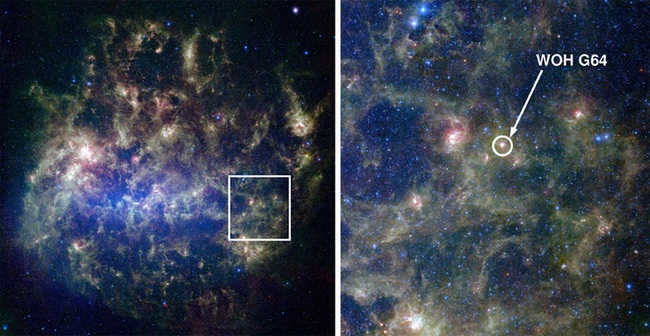
Occupying the second position among the enormous stars is this celestial body known as the Large Magellanic Cloud. Situated 160,000 light years away from our planet, this galaxy has a radius that is equivalent to 1,738 Earth radii. Astronomers estimate that this star is approximately 1,540 times larger than the Sun. Precisely determining its size is challenging due to its location within a dust cloud, which hinders scientists from making accurate measurements.
3 R136a1.
can be paraphrased as
The third star in the R136a1 system.
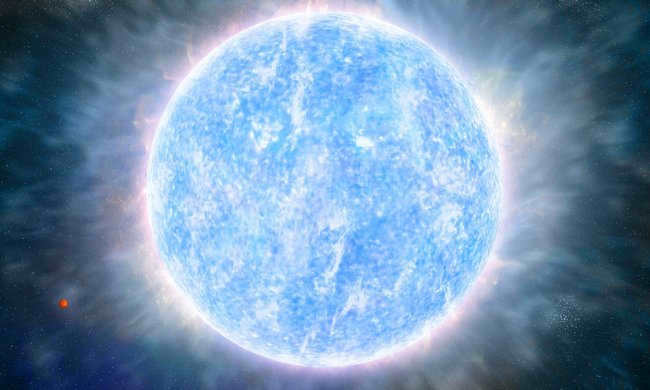
There is another star situated in the Large Magellanic Cloud. The discovery of this star was made possible thanks to a NASA telescope back in 2010. In terms of mass, this enormous star is 256 times greater than the mass of the Sun. It emits light that is 10 million times brighter than our own. Stellar objects like this are quite uncommon, as they are formed within dense clusters of stars.
4 VV Cepheus A.
The fourth VV Cepheus A is the subject of much study and fascination. Scientists and astronomers have been captivated by this celestial object due to its unique characteristics and properties. With its distinct brightness and variability, 4 VV Cepheus A has become a significant point of interest in the field of astrophysics.
This remarkable star system is located in the constellation Cepheus, and it consists of two massive stars orbiting each other closely. The primary star is a red supergiant, while the secondary star is a blue main-sequence star. The size difference between these stars is enormous, with the red supergiant being hundreds of times larger than its companion.
One of the most intriguing aspects of 4 VV Cepheus A is its variability. The primary star undergoes irregular changes in brightness, which can be attributed to various factors, such as pulsations and mass loss. These variations have made it a prime target for astronomers studying stellar evolution and the physics of massive stars.
Furthermore, the interaction between the two stars in this system has sparked interest among scientists. The gravitational forces between them cause significant effects, such as mass transfer and the formation of a circumstellar disk. These phenomena offer valuable insights into the dynamics of binary star systems and the processes that occur within them.
In conclusion, 4 VV Cepheus A is a celestial object that has captivated the scientific community. Its unique characteristics, such as its variability and binary nature, make it an excellent subject for study and research. By investigating this star system, astronomers can gain a better understanding of stellar evolution and the intricate dynamics of binary stars.
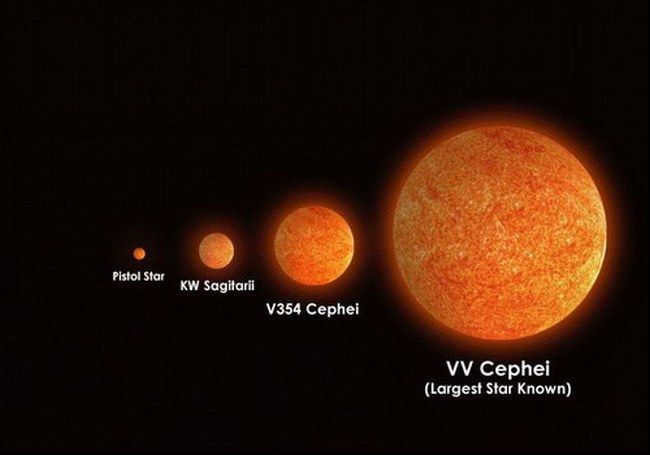
Situated at a distance of 3000 light years from our planet, this celestial object boasts a radius equivalent to 1600-1900 times that of the Sun. Nestled within the Cepheus constellation, this crimson supergiant possesses a diameter spanning approximately 2.6 billion kilometers. In terms of luminosity, this star outshines the Sun by a staggering factor of 275,000-575,000.
Five Kentucky Swan.
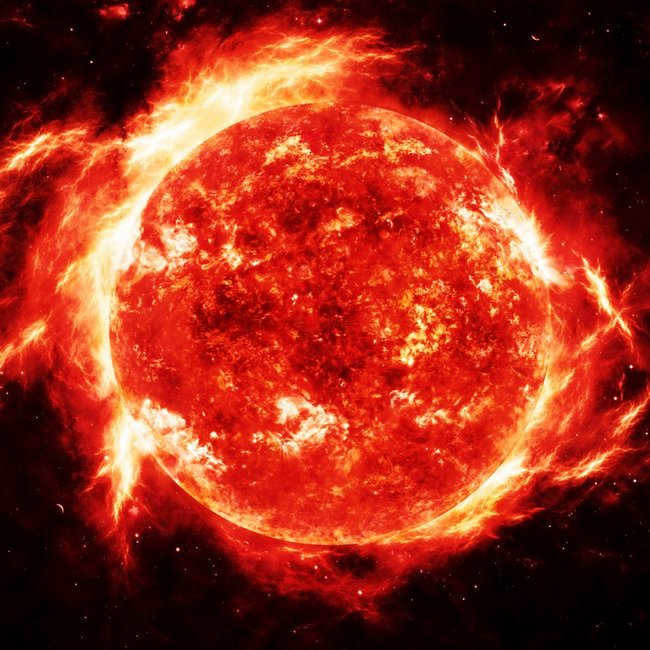
The size of this particular star in the Swan constellation is equivalent to more than 1400 times the radius of the Sun. Situated 5300 light years away from Earth, this celestial entity would extend its outer boundary to the orbit of Jupiter if it were placed at the center of our solar system.
Scientists have recently discovered another enormous star in the constellation of Sagittarius. This pulsating variable object is characterized by constantly changing volume and temperature. According to scientific findings, this star is a staggering 1520 times larger than our own celestial luminary. The regular pulsation of this star resembles the rhythmic beating of a human heart.
And this is just the tip of the iceberg when it comes to the largest stars that have been uncovered. Astronomical research is ongoing, and scientists are determined to uncover even more colossal objects within the vast world of stars.
*This article presents an overview of the top-rated stars according to the editors of expertology.ru. The selection criteria used are subjective and not intended as advertising or a purchasing guide. It is recommended to consult with an expert before making any purchases.
When gazing at the night sky, the stars appear as distant, twinkling lights that appear minuscule. However, this perception is deceiving. Stars are massive spheres of intensely hot matter that undergo continuous thermonuclear reactions, resulting in their dazzling brightness that allows their rays to reach our planet from the far reaches of the Universe.
Some stars are truly enormous, to the extent that the Sun itself appears as a mere speck in comparison. In this article, we have gathered information on the 10 largest stars in the Universe.
Ranking of the biggest stars in the Universe
| Nomination | place | star | diameter |
| ranking of the largest stars in the universe | 10 | Mu Cepheus | 1260 SOLAR RADII |
| 9 | V766 Centauri | 1315 SOLAR RADII | |
| 8 | AH Scorpius | 1411 SOLAR RADII | |
| 7 | KY Swan | 1420 SOLAR RADII | |
| 6 | VX Sagittarius | 1520 SOLAR RADII | |
| 5 | Westerland 1-26 | 1530 SOLAR RADII | |
| 4 | RW Cepheus | 1535 SOLAR RADII | |
| 3 | WOH H64 | 1540 SOLAR RADII | |
| 2 | VY Big Dog | 1540 SOLAR RADII | |
| 1 | UY of the Shield | 2100 SOLAR RADII |
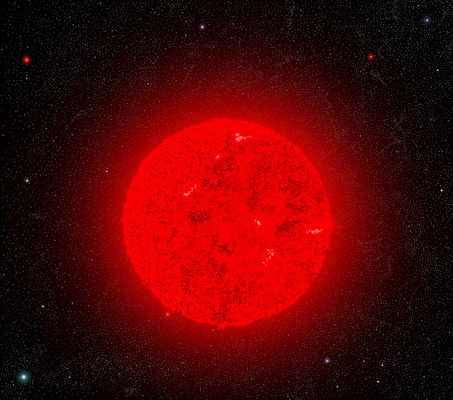
Mu Cepheus, located in the constellation Cepheus, is a red supergiant that can be easily seen with the naked eye due to its high brightness (with an apparent magnitude of up to +3.5). It was first discovered by the German astronomer William Herschel between 1780 and 1783.
Herschel described the light emitted by Mu Cepheus as a vibrant shade of red, which is why it is sometimes referred to as Herschel’s Garnet Star.
One interesting feature of Mu Cepheus is its extreme instability. As a red supergiant, it undergoes constant changes in its luminosity, brightness, and even its color. This means that at times it can be easily spotted in the night sky, while at others it requires closer observation. Its apparent stellar magnitude can vary from +3.4 to +5 over a period of 2 to 2.5 years.
The instability observed in Mu Cepheus indicates that its life cycle has reached its conclusion. The star has already consumed all of its hydrogen through thermonuclear reactions and is now in the process of depleting its helium. In a matter of a few million years, it is expected to undergo a supernova explosion and transform into a black hole.
Mu Cepheus, located over 5,200 light-years away, is a staggering 1,260 times bigger than our Sun.
Coming in at 9th place is V766 Centauri, with a radius of 1,315 times that of our sun!
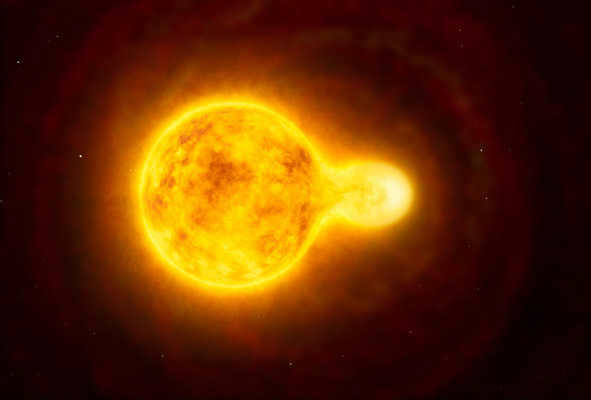
V766 Centauri (HR 5171 A) is the largest star in the Centauri constellation. It is worth noting that it is a double yellow supergiant, which means that its spectral characteristics (such as the type of thermonuclear reactions and luminosity temperature) are similar to those of our “yellow dwarf” star. However, what sets it apart is the presence of a companion star, HR 5171 B, which orbits in close proximity.
The companion star orbits V766 Centauri so closely that it almost touches its surface. Despite being much smaller, approximately 48 times smaller than its “neighbor,” it is not drawn in by the gravitational pull of HR 5171 A. The companion star takes about 1300 “our” days to complete one orbit around V766 Centauri.
V766 Centauri is 1315 times larger than the Sun, emits a bright yellow hue, and is situated 11700 light years away from our location. It possesses an apparent stellar magnitude of +6.51 and can be easily discerned by the naked eye.
8th place: AH Scorpius (1411 solar radii)
AH Scorpius represents the largest star within the constellation Scorpius, a dying red supergiant. It is currently approaching the final stages of its lifecycle, with even its helium supply dwindling. Consequently, we anticipate AH Scorpius to undergo a supernova explosion in the immediate future.
The size of AH Scorpius is enormous, being 1411 times larger than the Sun. Additionally, it emits a dim red light and is positioned 7400 light years away from us.
Taking the 7th spot is KY Swan (with a size of 1420 solar radii)

KY Swan, situated in the Swan constellation, is the largest dying red supergiant. Despite its impressive dimensions, it remains invisible to the naked eye and can only be observed through a telescope. The reason for this is that KY Swan is currently in its final stage of stellar evolution and is anticipated to undergo a supernova explosion in the near future.
KY Swan is categorized as a gaseous extinction star. It has almost depleted its fuel and as a result, possesses a relatively low mass considering its immense size. Its outer envelope consists primarily of gaseous and highly rarified matter. Due to the low density, accurately determining its exact size poses challenges as it is unclear where the boundary between stellar and interstellar gas lies. Consequently, some researchers tend to overestimate its diameter.
KY Swan is 1420 times bigger than our Sun and approximately 25 times more massive. Despite its enormous size, the star has a relatively low apparent stellar magnitude of +10.57, making it invisible to the naked eye. If you want to catch a glimpse of this giant star, you’ll need to rely on a telescope or other advanced equipment. KY Swan emits a dim red light with a temperature of 3500 K and is situated at a distance of over 5100 light-years from Earth.
Rank 6: VX Sagittarius (1520 times the size of the Sun)
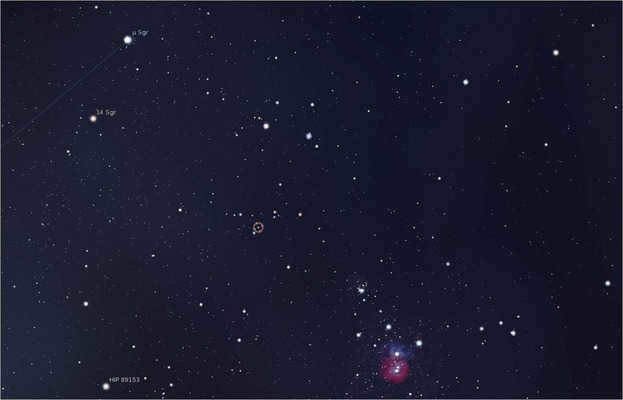
VX Sagittarius is not only remarkable for its size, but also for its unique behavior. It is a pulsating star that undergoes periodic expansion and contraction. This behavior is attributed to the star’s imminent supernova explosion, as most of its fuel has already been consumed through thermonuclear reactions.
Despite being on the verge of explosion, VX Sagittarius is still held back by a stellar wind. The star continuously ejects matter from its core into the surrounding space. As a result, VX Sagittarius is a relatively lightweight star with a thin gas envelope.
Nevertheless, it emits an extraordinary amount of light and is considered one of the brightest red supergiants. However, it cannot be observed with the naked eye due to its apparent magnitude, which ranges from +14 to +6.5. Observing VX Sagittarius would require the use of a telescope or similar equipment.
VX Sagittarius is approximately 1520 times bigger than our Sun and is also about 12 times more massive. It emits a vibrant red light with a temperature of 3575 K and is situated at a distance of around 5300 light-years.
Position 5: Wetherland 1-26 (1,530 solar radii)
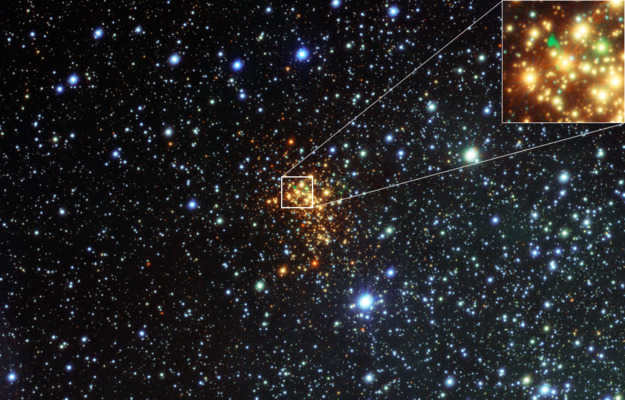
The red supergiant Westerland 1-26 can be found within a gathering of stars situated in the constellation Sacrilege. It is positioned at a considerable distance from us, resulting in limited knowledge about this celestial object. The Westerlund 1 star cluster itself was only identified in the year 1961.
Westerlund 1-26 stands as the most massive star within this cluster. Classified as a red supergiant, certain research findings even suggest that it may qualify as a hypergiant. This classification is attributed to the unique characteristics of its cosmic environment.
Therefore, in the vicinity of Västerland 1-26, there exists an immense concentration of ionized hydrogen, which serves as both a source of energy for the star and has the ability to influence its luminosity and spectral properties of its emitted radiation. Consequently, obtaining an accurate measurement of the star’s dimensions becomes a challenging task.
Based on the most reliable data available, it is estimated that Wetherland 1-26 is approximately 1530 times larger than our Sun. Emitting a vibrant red hue with a temperature of 3600 K, this colossal star is positioned at a staggering distance of 11500 light-years away from our location.
4th place: RW Cepheus (1535 solar radii)
RW Cepheus, situated in the constellation Cepheus, holds the remarkable title of being the largest star. It is a semi-regular variable red hypergiant that undergoes constant changes in both its physical size and luminosity due to its advanced stage of evolution. As a result, determining its exact dimensions is an impossible task.
Despite the challenges of measuring its size, RW Cepheus possesses a fascinating future. As a red hypergiant, it currently boasts an unusually immense size, while maintaining an extraordinarily low mass of only 40 solar masses. This unique combination suggests that when it eventually explodes, it has the potential to transform into a hypernova – a considerably brighter event than a supernova – and potentially even a black hole.
WOH H64 takes the 3rd spot with its massive size of 1540 solar radii
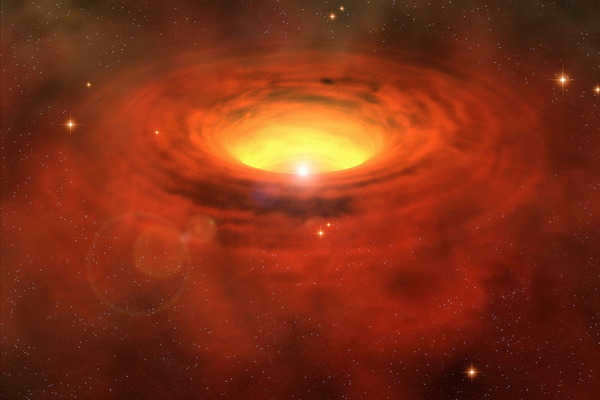
WOH H64 is not located in our own galaxy, but rather in a neighboring galaxy known as the Large Magellanic Cloud. The distance between this particular star and planet Earth is an astounding 163,000 light-years. However, WOH H64 is a rather familiar red supergiant, albeit one that rotates quite quickly.
As a result of the star’s rotation, a gas-dust cloud has taken on a rather unique shape – instead of being a typical sphere, it resembles a torus, similar to a “bagel”. This torus partially captures the red light emitted by WOH H64, causing its brightness to be slightly lower than expected. Nonetheless, this behavior of the red supergiant suggests that the star is in one of its final stages of evolution and will likely explode and transform into a supernova within the next few tens of thousands of years.
Due to its relatively low magnitude of +9.69, WOH H64 cannot be observed without the use of a telescope. The primary observations of this red supergiant have been conducted at the VLT laboratory in Chile.
Based on calculations, WOH H64 is estimated to be 1540 times larger than the Sun.
Runner-up: VY Big Dog (1540 solar radii)
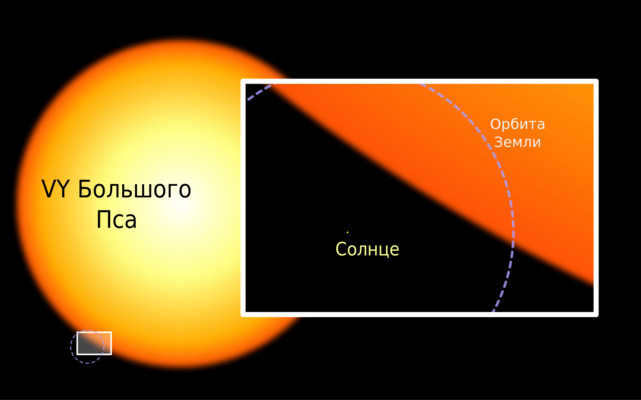
Photo: Nonexyst, CC0, via Wikimedia Commons
VY of the Big Dog is a massive star located in our galaxy. It is classified as a gas hypergiant, meaning it has an immense size but relatively low mass. In fact, it is only 11-25 times more massive than the Sun.
VY of the Big Dog is a highly luminous star that can be seen in the night sky. Its brightness varies from +9.6 to +6.5, making it visible to the naked eye. This was first observed by French astronomer Joseph Jerome de Lalande in 1801. Over the course of more than 200 years, this red hypergiant has undergone a transformation from a deep crimson color to a rich maroon, indicating its rapid evolution.
However, determining the precise size and characteristics of this star is a challenging task. VY of the Big Dog is surrounded by a cloud of gas and dust that hinders observation. Additionally, it experiences periodic flares, expelling vast amounts of matter into the surrounding space. Furthermore, it is highly porous, with its “surface” gas being even more rarified than the Earth’s atmosphere, making it difficult to discern the “boundary between space and the star.”
Astronomers have reached a consensus that VY Big Dog is preliminarily estimated to be 1540 times larger than the Sun. Moreover, it is situated approximately 3,900 light-years away from our planet.
Winner: UY of the Shield (2100 solar radii)
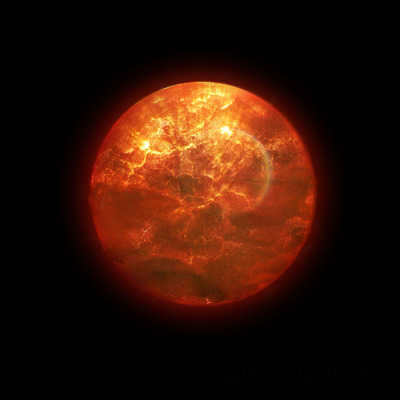
UY Shield is the largest star currently known in our galaxy, the Milky Way. It is a red hypergiant and is a whopping 2100 times larger than the Sun! Despite its immense size, UY Shield is surprisingly lightweight, much like other gas hypergiants. It has an estimated mass of 7-10 solar masses and its density is even lower than that of Earth’s atmosphere.
Since the 1860s, UY Shield has been included in star catalogs by astronomers from the Bonn Observatory. Although it can only be observed with a trained eye, it is visible with powerful binoculars or a simple telescope. UY Shield is located in the constellation of the same name, along the main axis of the Milky Way.
Shield’s UY emits a brilliant crimson light with a scorching temperature of 3365 K. As per a study conducted in 2018, its remarkably low mass can be attributed to its rapid consumption of matter. However, if it weren’t for the presence of interstellar dust, it would rank as the fifth most prominent celestial object in the sky.
Located approximately 9,500 light-years away from Earth, UY Shield remains a captivating spectacle.
The late summer and early fall seasons provide optimal conditions for stargazing. Yet, amidst our contemplation of the vast expanses of space, we often overlook the hidden enigmas concealed within these seemingly insignificant points of light. Onliner.by has meticulously compiled a comprehensive list of the top ten most enigmatic stars, consistently captivating astronomers worldwide.
10. An unparalleled giant
If you can still recall the name of the most colossal star from your school curriculum, feel free to discard it, for astronomers continuously discover more and more immense stars in the heavens. At present, the most colossal star known to us is the red hypergiant UY Shields. The magnitude of this celestial entity is mind-boggling – it is approximately 1,700 times larger than our Sun!
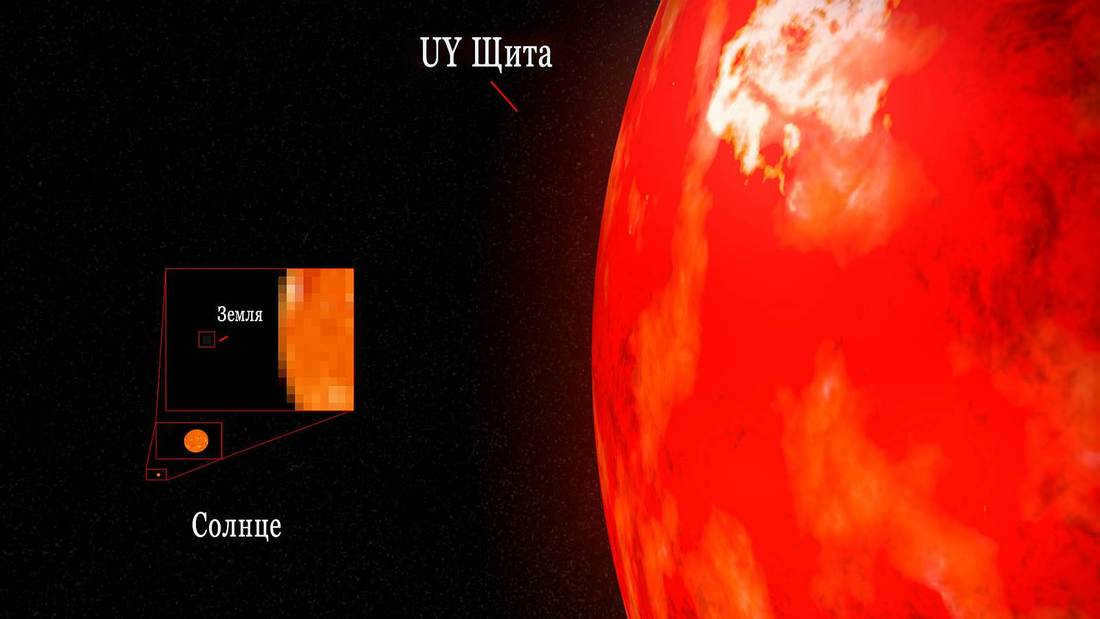
Imagine the tremendous size of the UY Shield, a celestial monster that could easily engulf our Sun. Its vastness is so immense that it could effortlessly absorb Earth, Mars, Jupiter, and even Saturn. The red giant emits an astonishing 340,000 times more energy than our Sun. If it weren’t for the presence of gas and dust clouds in our Galaxy, which absorb a significant amount of its light, the UY Shield would be the fifth brightest star in our sky.
9. The Enigma of Sirius
Concealed within the luminous radiance of the brightest star in the nocturnal expanse lies a cryptic enigma. Astronomers have bestowed the name Sirius B upon this diminutive companion star, though it is also fondly referred to as “Puppy”. This celestial body is no ordinary star, for it is the inaugural white dwarf ever discovered. White dwarfs are extraordinarily dense formations that emerge when stars, like our Sun, contract at the culmination of their lifespan.
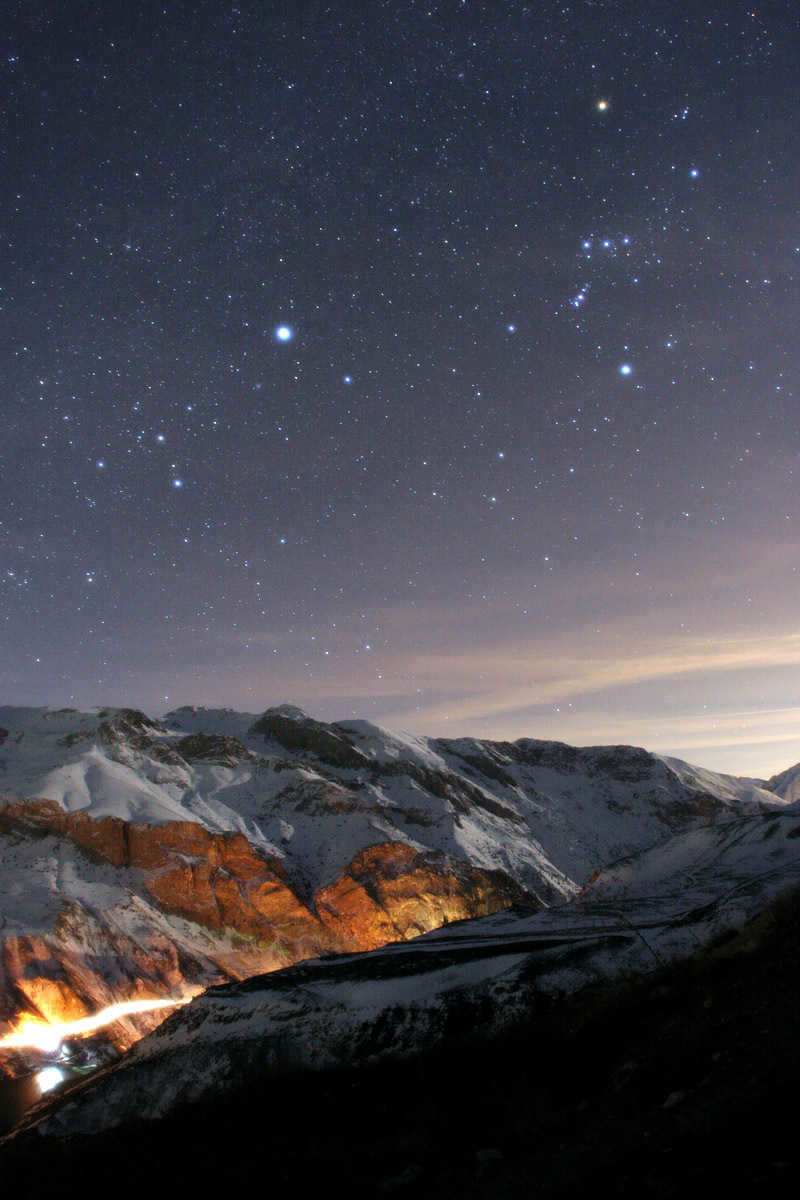
Stars with greater mass have a tendency to expire more quickly. Therefore, how is it possible that Sirius, which is over twice as massive as its companion, is still living, while the unfortunate Puppy is not? It is highly probable that during the phase preceding its demise as a red giant, a portion of the satellite’s outer layer exploded into the immediate vicinity, while another portion was absorbed by Sirius itself, thus replenishing its fuel reserves.
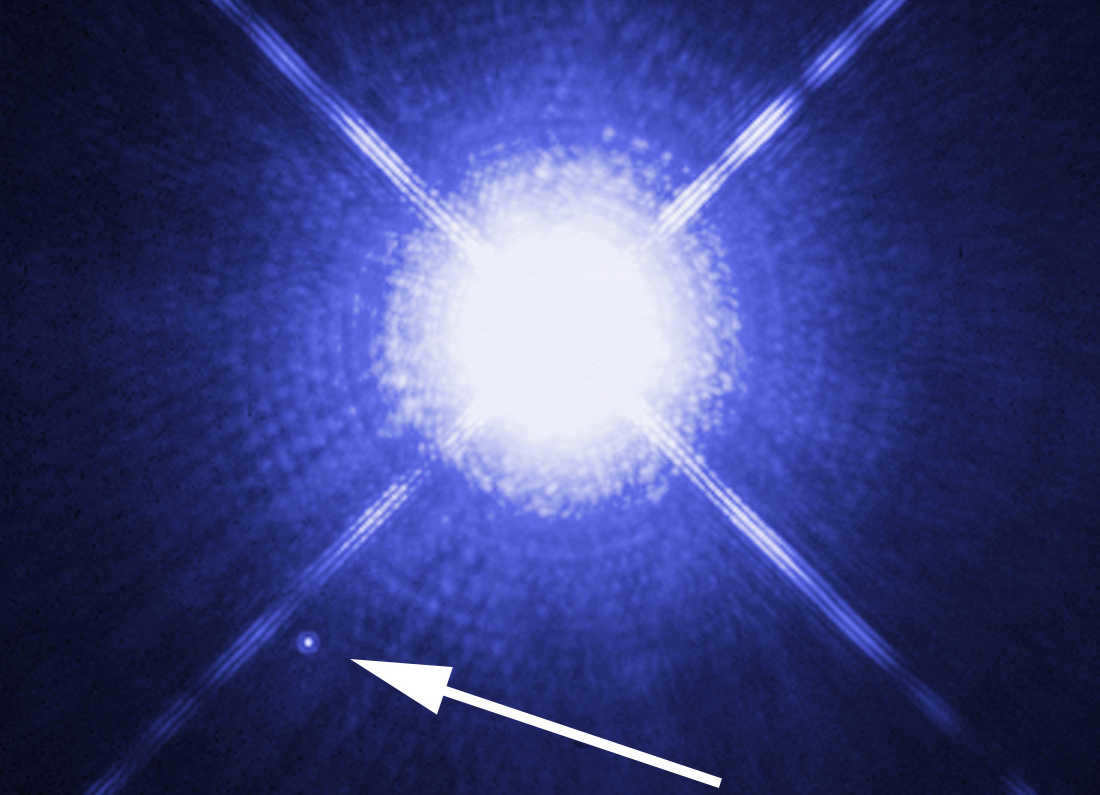
There are two enigmas linked to Sirius satellite, for which no one has managed to find answers yet. The initial one is that various ancient civilizations, including the Roman philosopher Seneca, portrayed Sirius as a bright red star, even though it is actually completely white. This observation might have been made during the phase when Sirius B was a red giant, but the transition to a dwarf star would have occurred so gradually that it would have been barely noticeable within such a short time span.
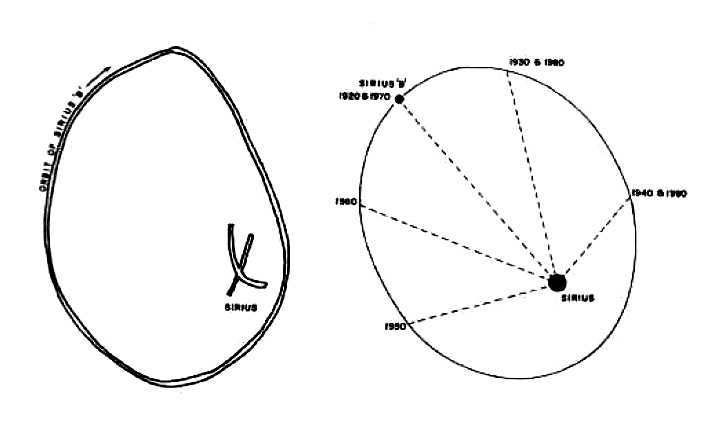
Another enigma lies with the African Dogon tribe, who, due to their isolation from the rest of the world, possessed accurate information about the Sirius system. They were able to describe both the satellite and the orbit it follows, and even had knowledge about its orbital period. According to their legends, this knowledge was bestowed upon them by mythical beings known as “nommu,” who resembled fish more than humans.
8. Star with spiral arms
Astrophysicists were astounded by the discovery of two prominent spiral arms encircling the celestial object known as SAO 206462, located in the constellation Wolf. These spiral structures bear a striking resemblance to the gas and dust disks commonly found surrounding youthful stars. However, the presence of such spirals within this particular disk can only be attributed to the ongoing formation of new planets within them. This extraordinary star has provided scientists with a unique glimpse into the past, allowing them to envision the potential appearance of our own solar system during its developmental stages.
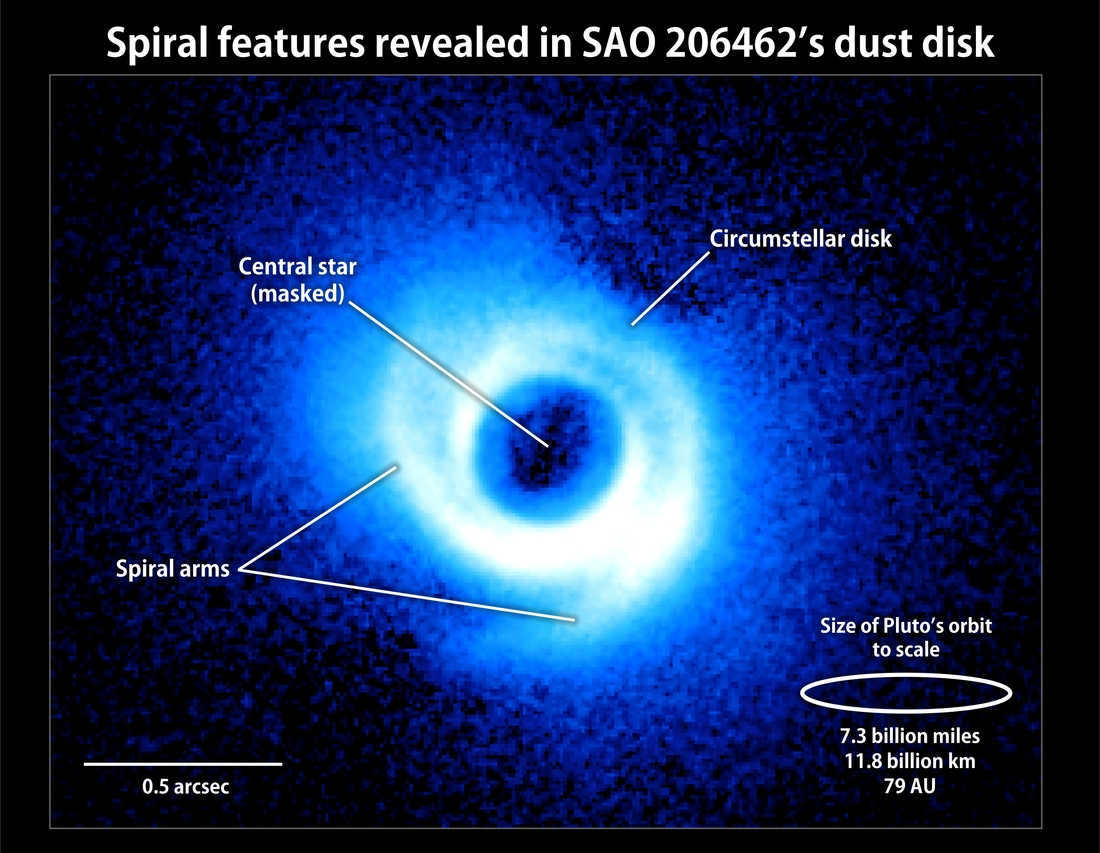
7. A dance in the sky with seven suns
At first sight, the star Nu in the Scorpius constellation, positioned at the tip of its claw, appears ordinary. However, this celestial body is composed of a remarkable seven components – a record-breaking number among multiple stars!
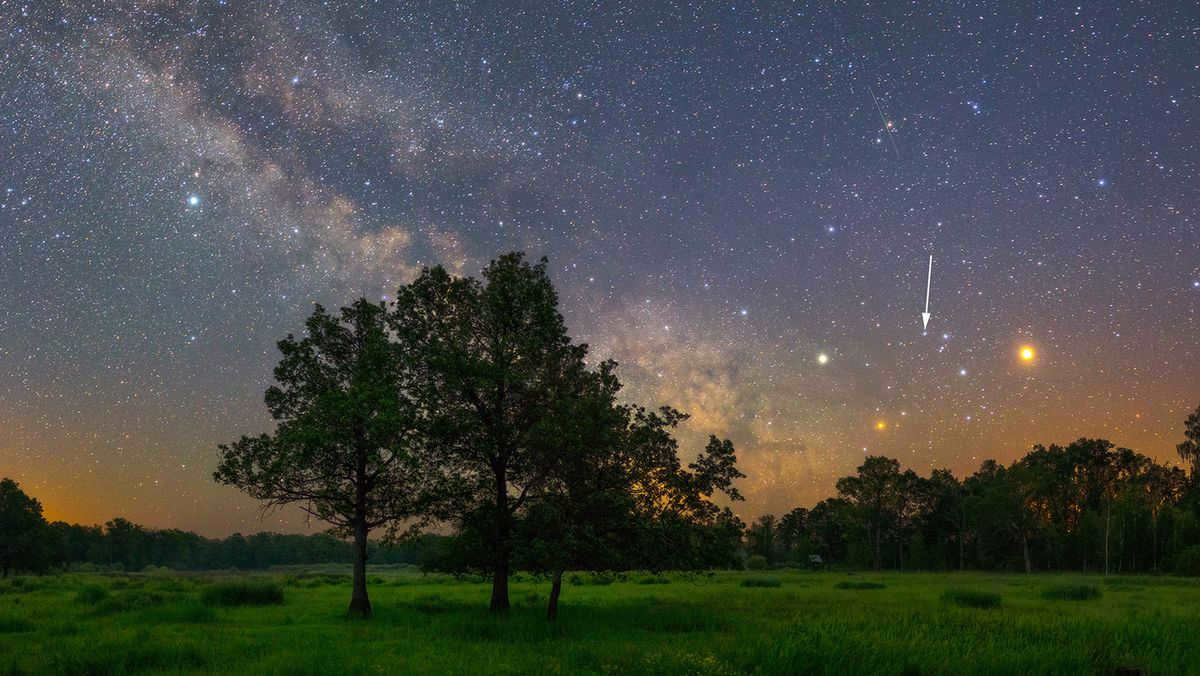
It is true that the stars in the Universe are not always solitary. According to certain calculations, approximately half of all celestial bodies come together in pairs, where both parts revolve around a shared center of mass. Triple stars are much rarer, and the principle of “the third is unnecessary” always holds true: during the exchange of energy between the stars, one of them will inevitably acquire excessive momentum and depart from the system.
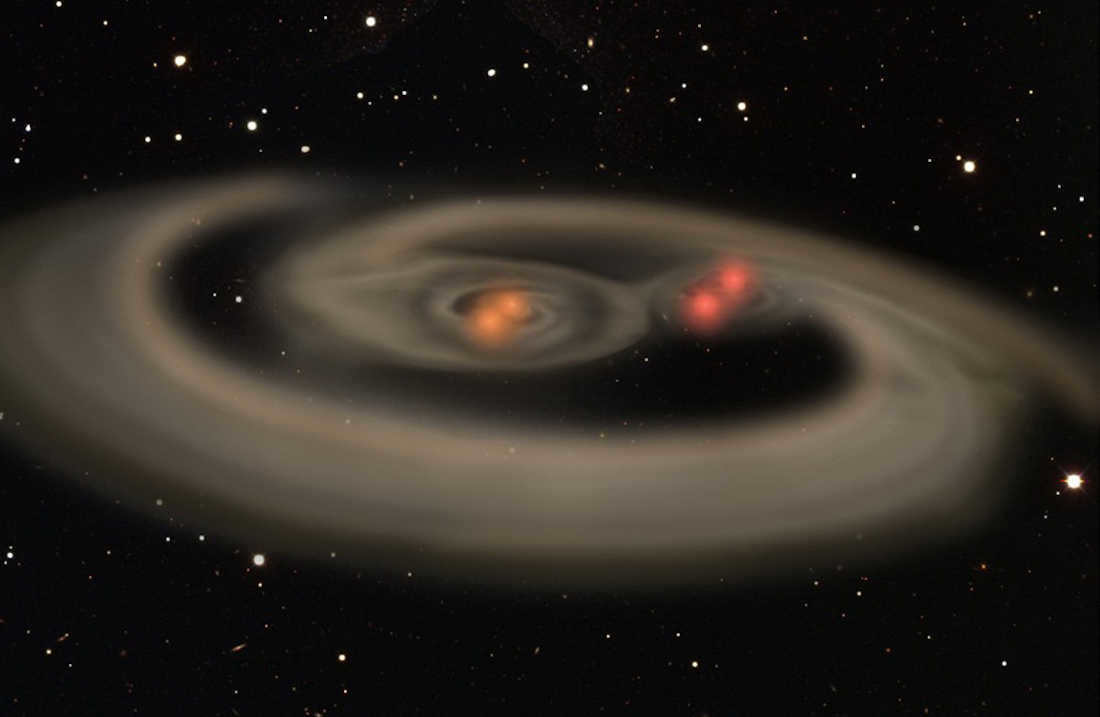
Survival of triple, quadruple, and other multiple star systems is contingent upon their hierarchical arrangement. For instance, two stars may be in close proximity to each other while the third star is situated at a much greater distance. It is improbable that such a stable hierarchy can be established for 7x Nu Scorpius, and over an extended duration of time, it is likely to fragment into two or three smaller systems.
6. The Most Enormous Diamond in the Universe
“The heavens adorned in brilliant diamonds” is a phrase often used by poets to describe the breathtaking view of the starry sky. However, amidst the countless shimmering stars, real diamonds can sometimes go unnoticed, and this is not just a poetic metaphor. One such diamond, known as BPM 37093, has gained significant fame.
BPM 37093 is not an actual diamond, but rather a white dwarf star that has reached the end of its life cycle after a billion years. It has a mass slightly greater than that of the Sun, yet it is roughly the same size as the Earth. This white dwarf is primarily composed of oxygen and carbon, elements that were formed during the star’s lifetime. Fortunately for scientists, BPM 37093 also exhibits pulsations as it cools down, providing valuable insights into its internal structure. These findings have turned out to be quite intriguing.
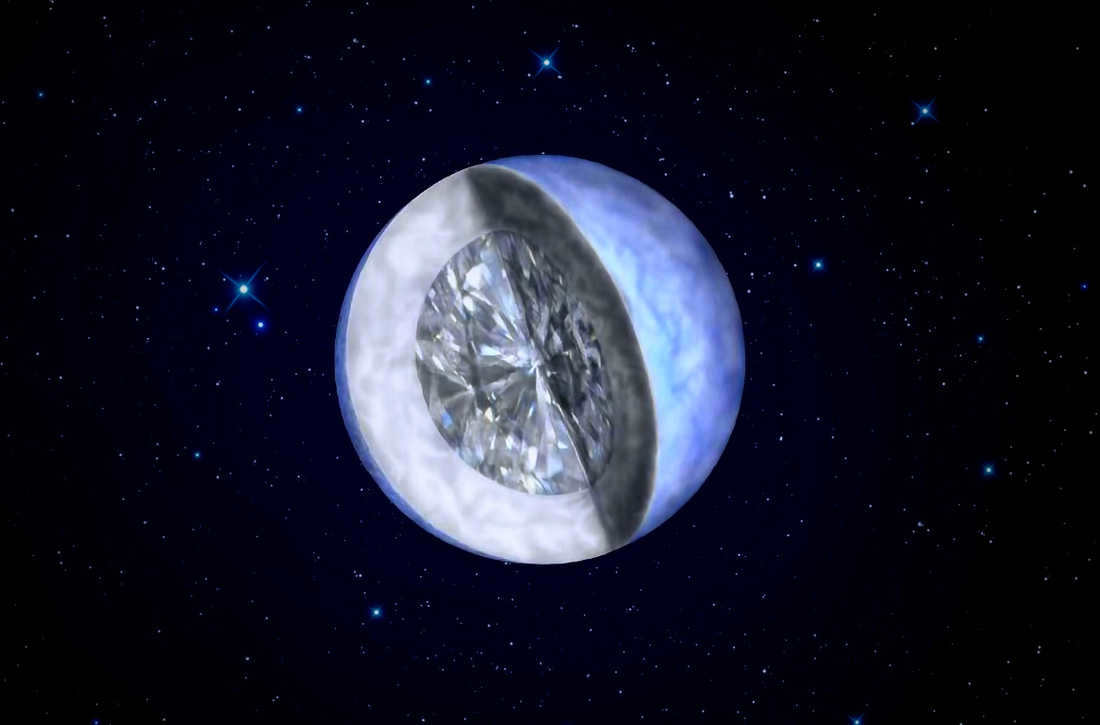
According to different calculations, somewhere between 30% and 90% of the mass of the star exists as a crystalline form. Due to the immense pressure within the star, astronomers have determined that the carbon present in the star is essentially a massive diamond. Interestingly, this star has been informally named Lucy as a tribute to The Beatles’ song “Lucy in the Sky with Diamonds.”
In the designation of this extraordinary celestial body, the symbol “X” signifies the existence of X-ray emissions, while the numeral “3” denotes that this represents the third occurrence of such a phenomenon identified within the Swan constellation. It might appear that astronomers are encountering a paradigmatic scenario: a binary system composed of a high-mass star and a dense non-radiating entity, with the entities continuously emitting X-rays. In these circumstances, researchers arrive at an unequivocal deduction: the unilluminated constituent is none other than a gradually consuming black hole.
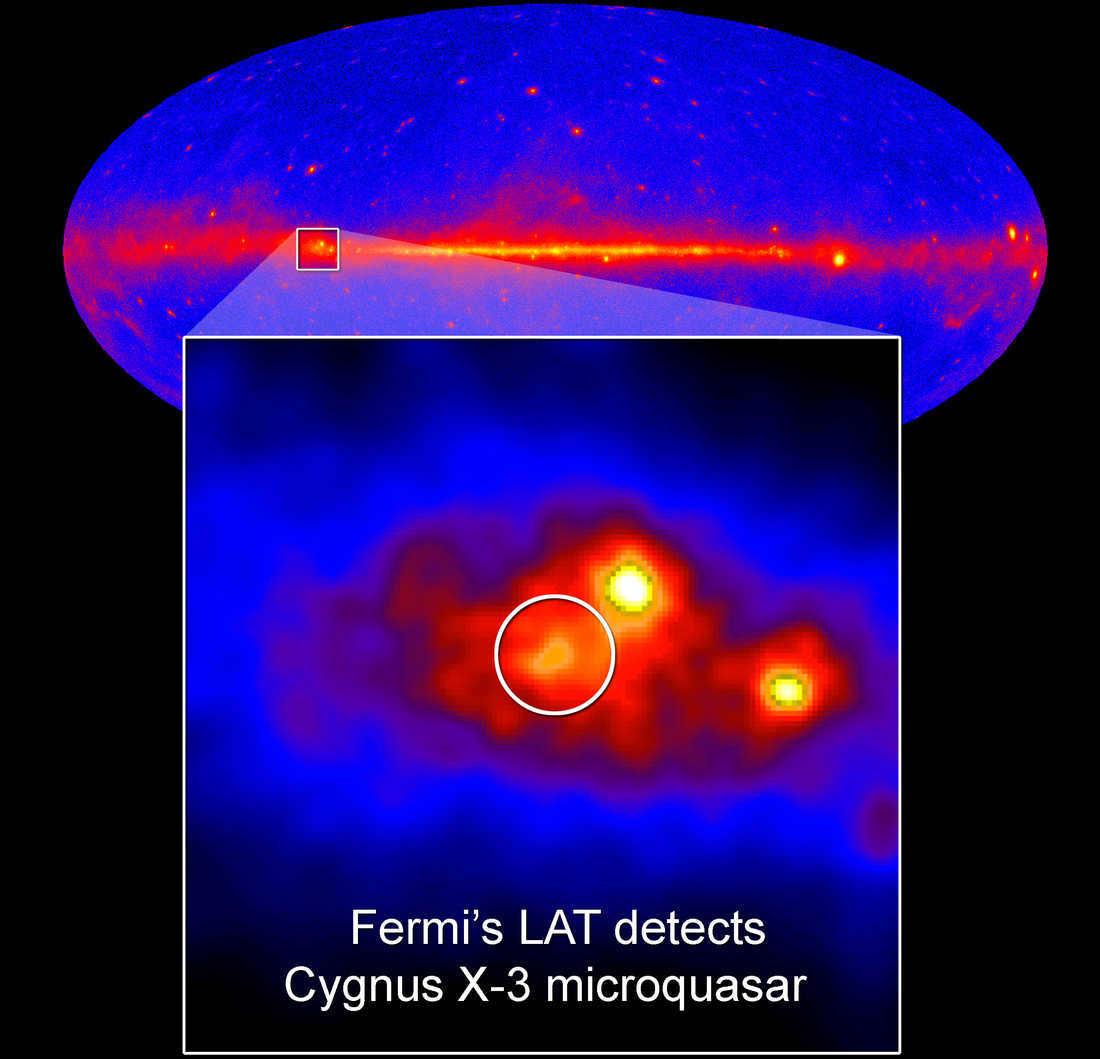
The Swan X-3 is not the most luminous object in the X-ray range due to its distance and the absorption of radiation by the Milky Way’s dust.
However, the X-ray power of Swan X-3 is simply astonishing: it shines more brightly than 100,000 suns in this range alone, surpassing all other ranges of the spectrum. Additionally, the system emits strong radio and gamma rays, which is not typical for objects of this kind. Furthermore, experimental data suggests the presence of a stream of other high-energy particles emanating from the star.
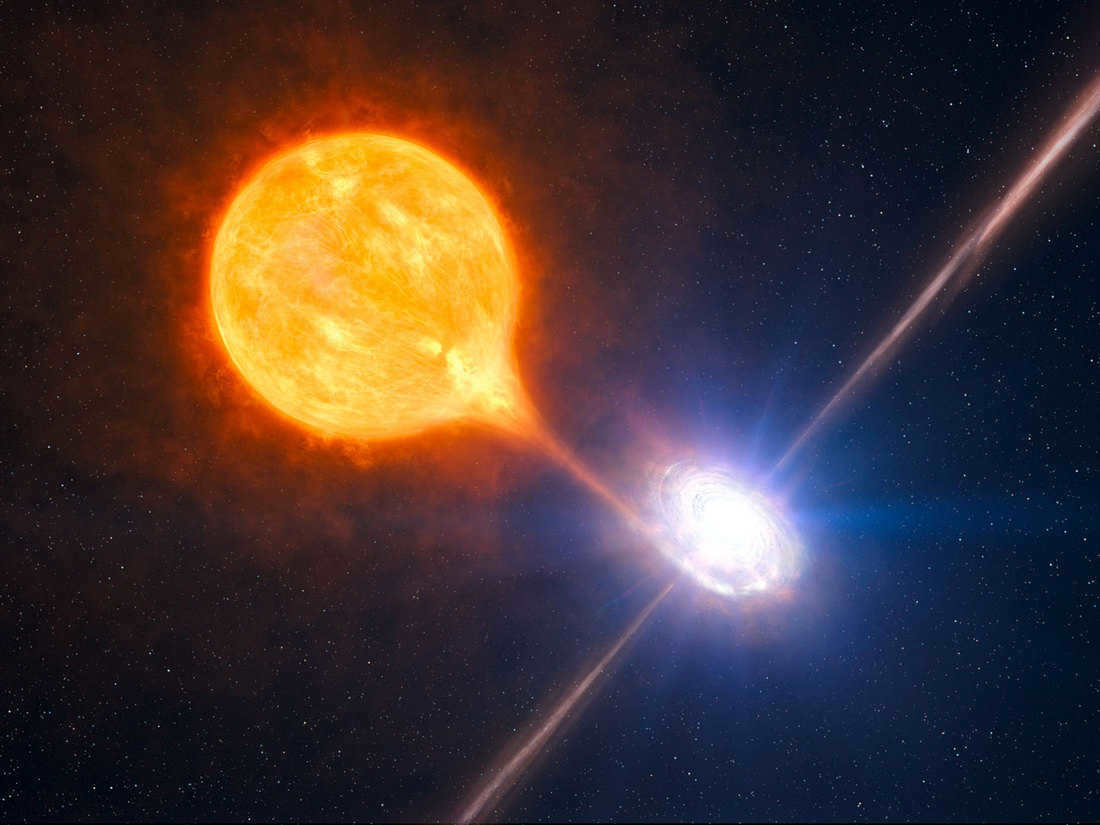
A special term, “microquasar,” has been coined by astronomers to describe these objects. However, when compared to other microquasars, Swan X-3 remains a significant enigma for scientists.
4. The dual beacon of the Universe
The most extraordinary pair of stars in the sky is known as PSR J0737-3039. These are two minuscule luminaries, each barely larger than the diameter of Minsk within the Moscow Ring Road. These superdense objects represent the final stage of heavy star life. Inside them, due to immense pressure, there is no matter in the form of atoms and molecules; rather, the matter is a mere cluster of neutrons.
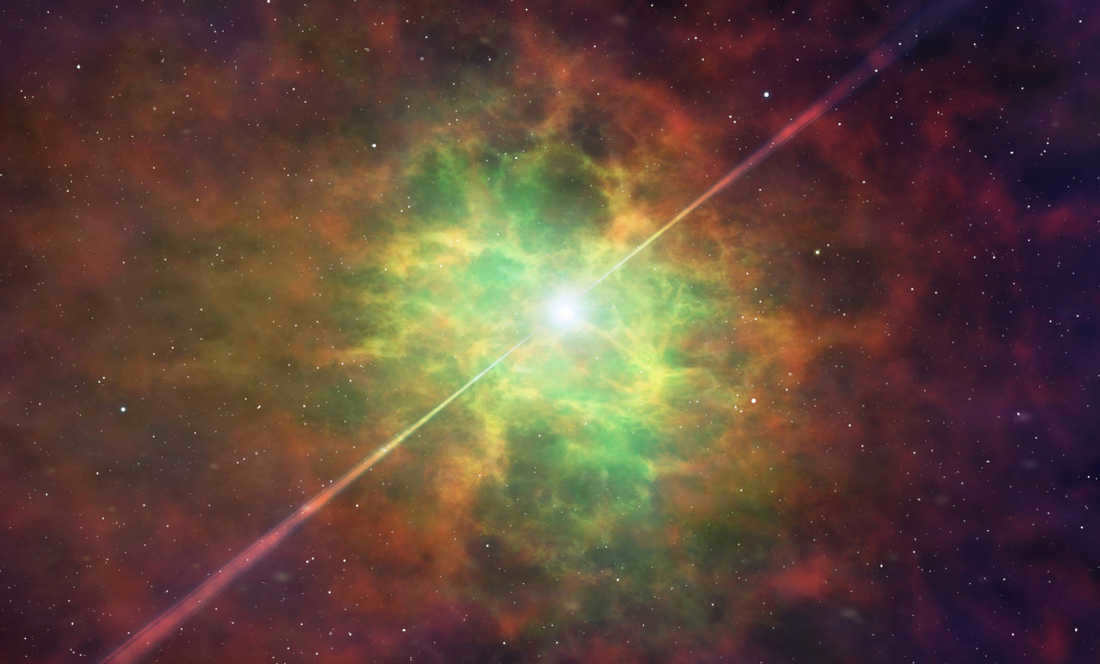
A lot of these celestial bodies have the ability to produce radio waves by emitting two extremely narrow beams that are directed in opposite directions. And if, by chance, one of these beams happens to hit the Earth during the rotation of such a star, our instruments will detect a brief burst of radio waves with each revolution. Due to this pulsating behavior, these stars are referred to as pulsars.
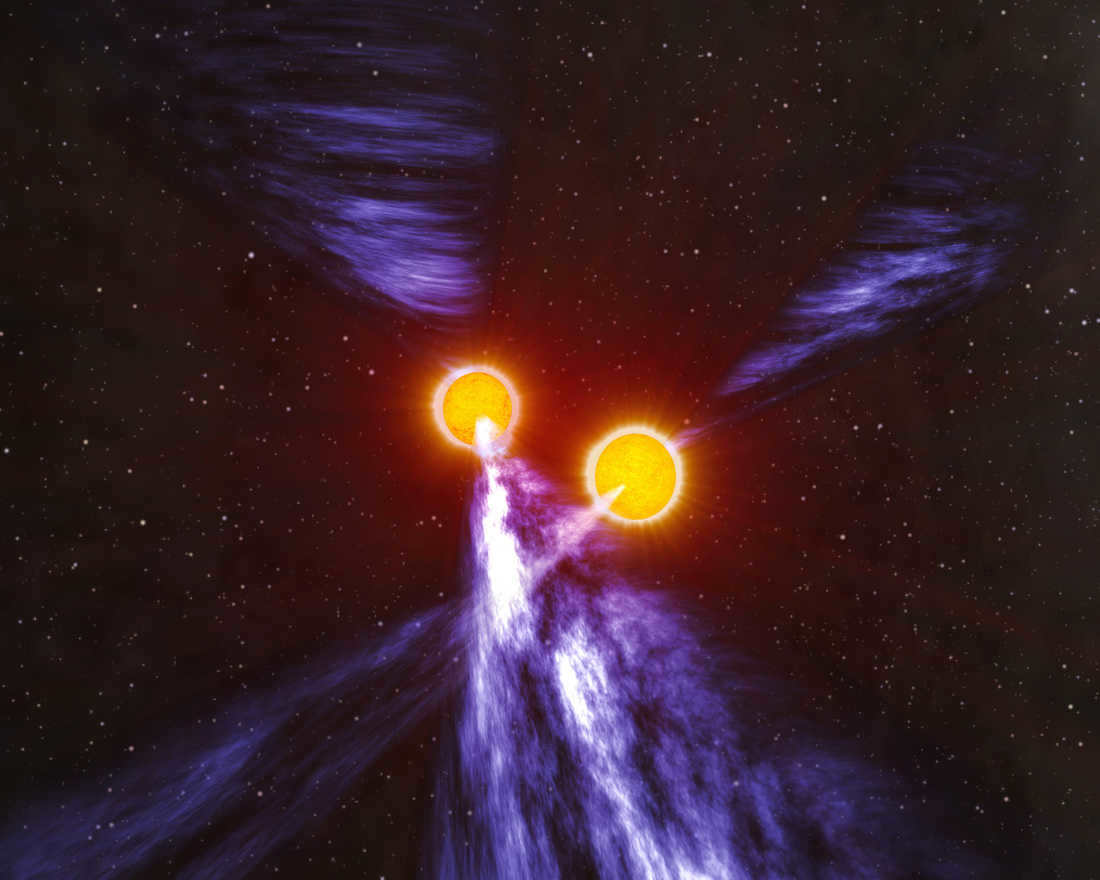
Discovering a pulsar in the cosmos is an extraordinary stroke of luck for astronomers. And stumbling upon a binary system with two pulsars orbiting each other in a span of over two hours is truly a remarkable find! PSR J0737-3039 provided the perfect setting to investigate numerous phenomena predicted by Einstein’s general theory of relativity, which, until then, remained unverifiable on our home planet.
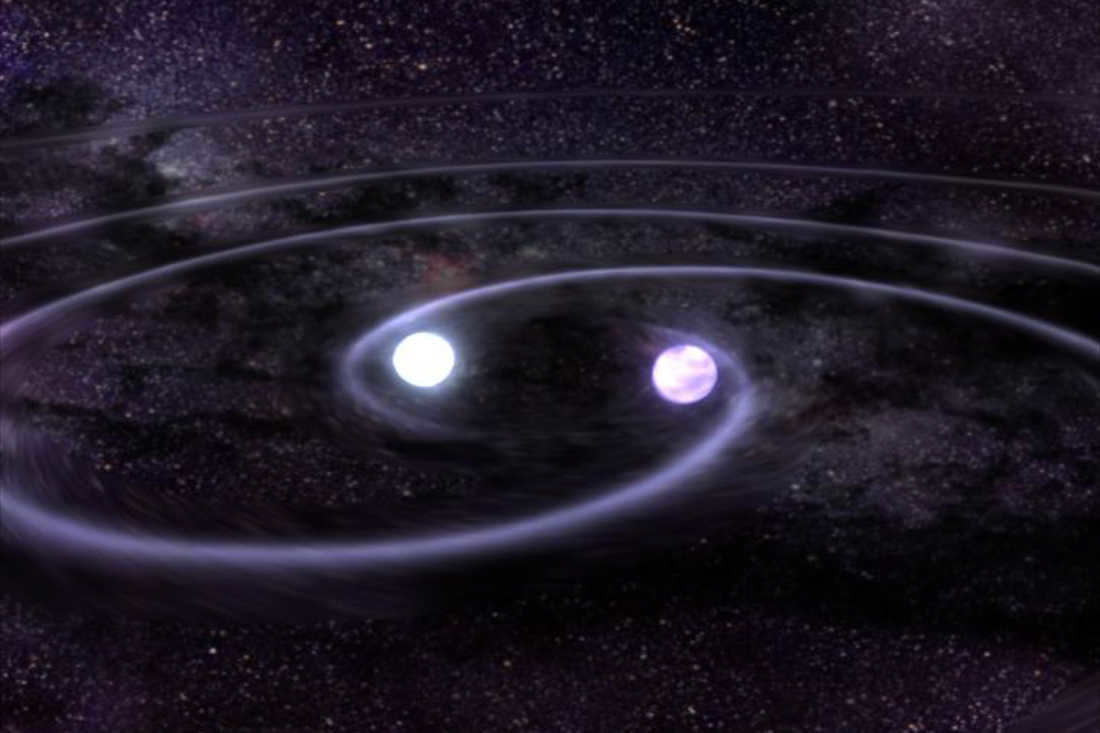
Einstein deserves recognition for the flawless success of his theory in every test. Through the examination of this system, researchers were even able to obtain the initial verification of the presence of gravitational waves long before their direct detection. Consequently, the individuals who uncovered the dual pulsar were awarded the Nobel Prize in Physics in 1993.
3. The enigmatic Unicorn blast.
The nondescript variable star V838 in the Unicorn constellation gained instant notoriety. And the cause of this was a calamity: on January 6, 2002, the celestial body unexpectedly detonated without any discernible cause. The explosion was so intense that it created a luminous echo in the gas and dust enveloping the star.
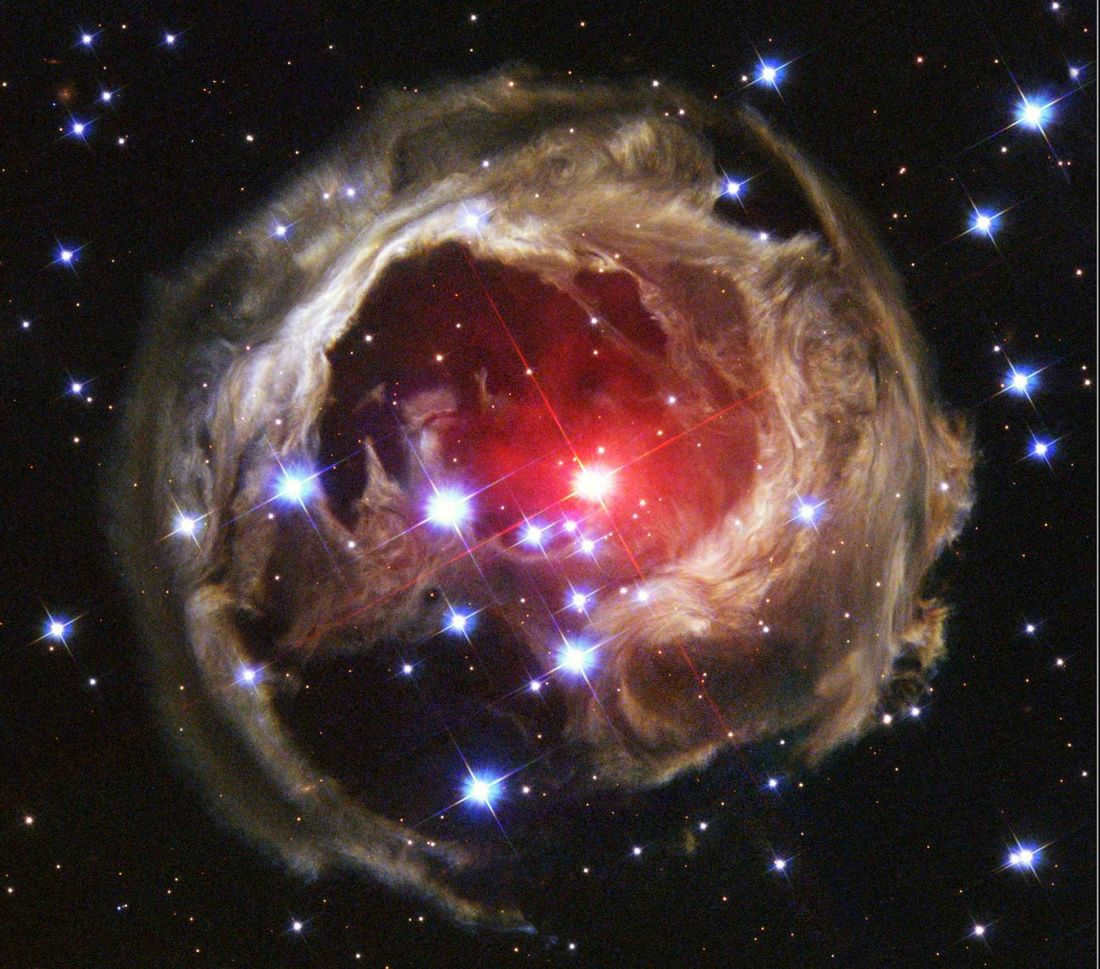
In the beginning, astronomers believed they had witnessed a typical eruption of a newly formed star (even though these stars are no longer considered young). However, V838 displayed unconventional behavior for a new star. Instead of shedding its outer layers during the explosion, the star expanded to massive proportions, temporarily becoming one of the largest and brightest stars ever observed by scientists. Simultaneously, its surface temperature drastically decreased and did not surpass the temperature of a filament in an incandescent light bulb. This is why the star appears deep red in the images.
The Hubble images depict the animation of the light echo phenomenon.
The current state of V838’s condition is still an enigma that has yet to be solved. One theory suggests that we witnessed the fusion of two stars from a binary system. However, further investigation is required to validate this hypothesis and other potential explanations.
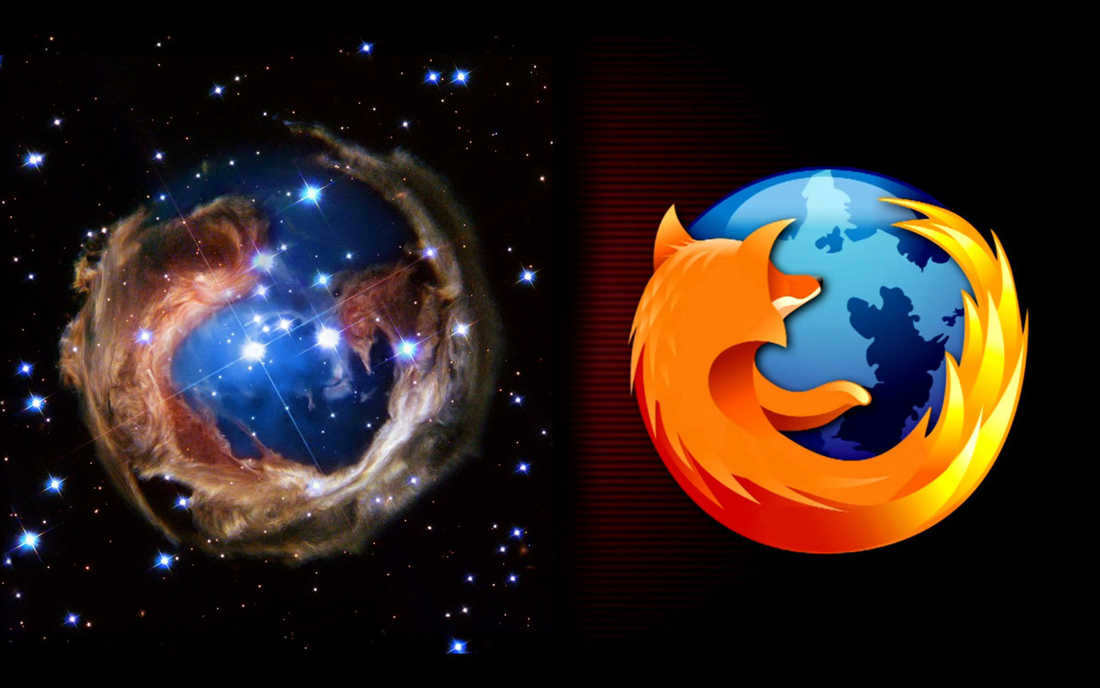
2. A colossal extraterrestrial construction site
In the autumn of 2015, the star KIC 8462852 astounded researchers with unexpected “winks”. It was unintentionally found during the exploration for exoplanets using the Kepler telescope. The pattern of light fluctuations bore a striking resemblance to what astronomers typically observe when a planet transits across a star’s disk, however, the dips in brightness were exceptionally profound and simultaneously unpredictable.
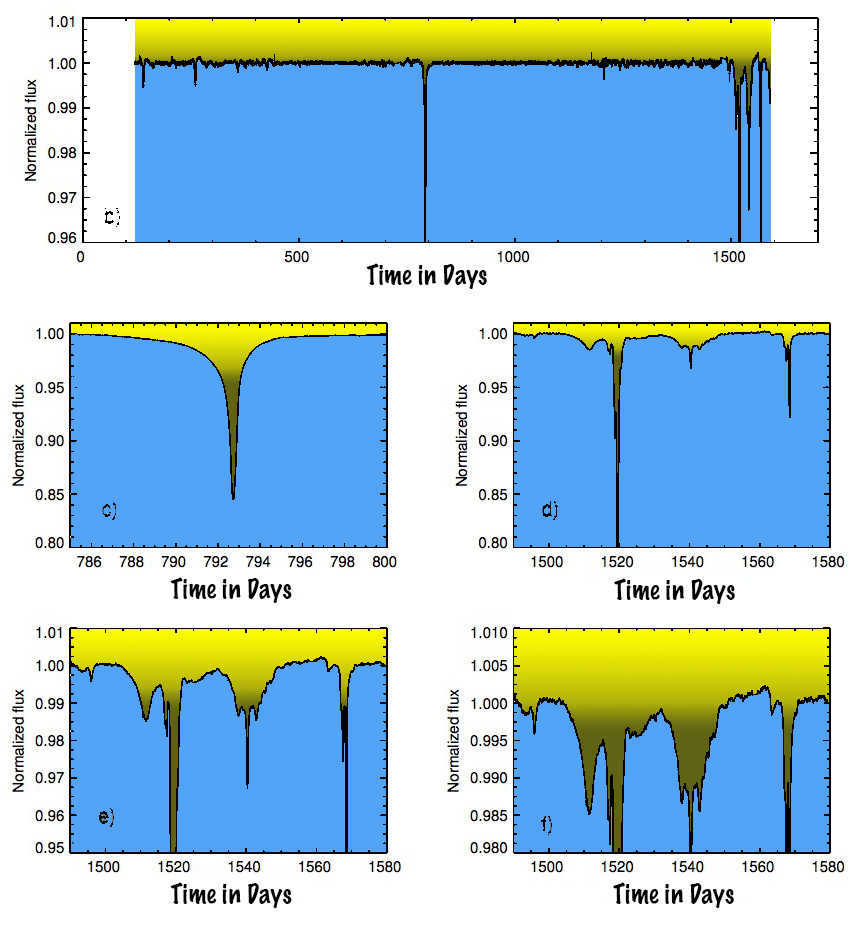
The behavior of the star cannot be fully accounted for by any current theory. As a result, a somewhat fantastical hypothesis has emerged suggesting that an advanced civilization has constructed a massive structure around the star, intermittently obstructing some of its light. These structures, known as “Dyson spheres,” have long been predicted by futurists, and the identification of such an object could serve as evidence for the existence of extraterrestrial life.
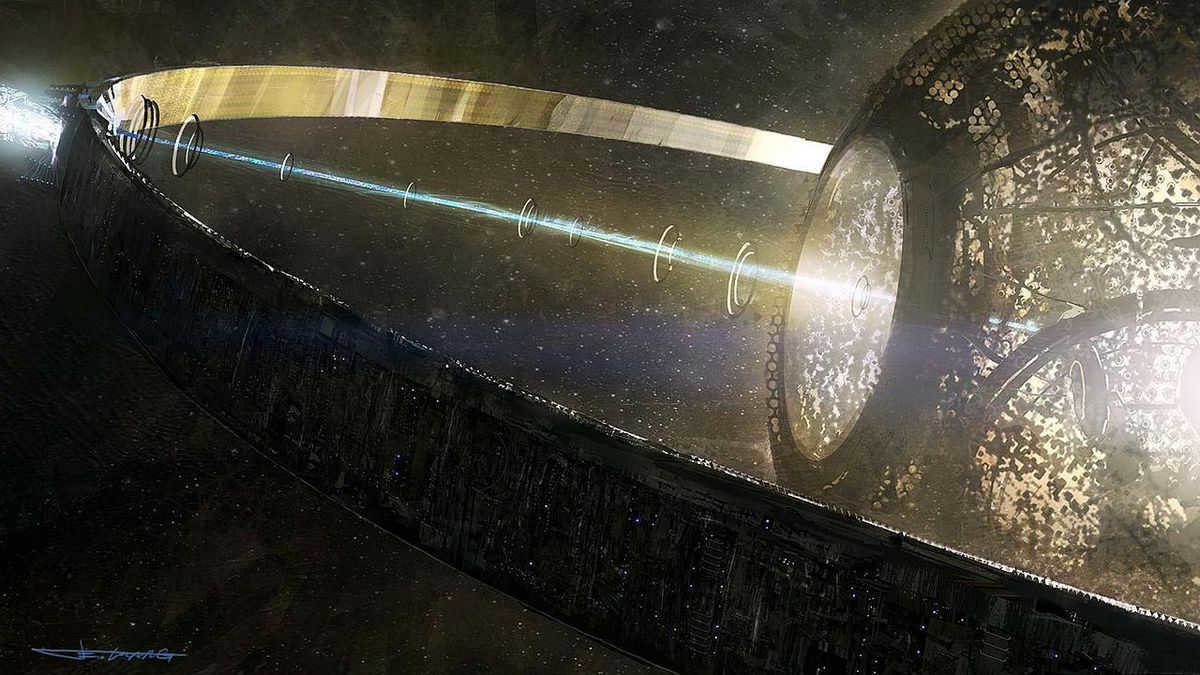
While it is improbable for scientists to anticipate encountering extraterrestrial life near KIC 8462852, it is this conjecture that has garnered significant attention in the media and has even facilitated the raising of $100,000 on Kickstarter for the purpose of studying this celestial body over the course of the next two years.
In the 18th century, astronomers were captivated by this seemingly ordinary star due to its peculiar fluctuations in luminosity. The brightness of the celestial body experienced abrupt and repetitive alterations, both increasing and decreasing in intensity. It was in the year 1838 when the remarkable event known as the Great Eruption of Eta Kiel commenced, leaving astronomers in awe.
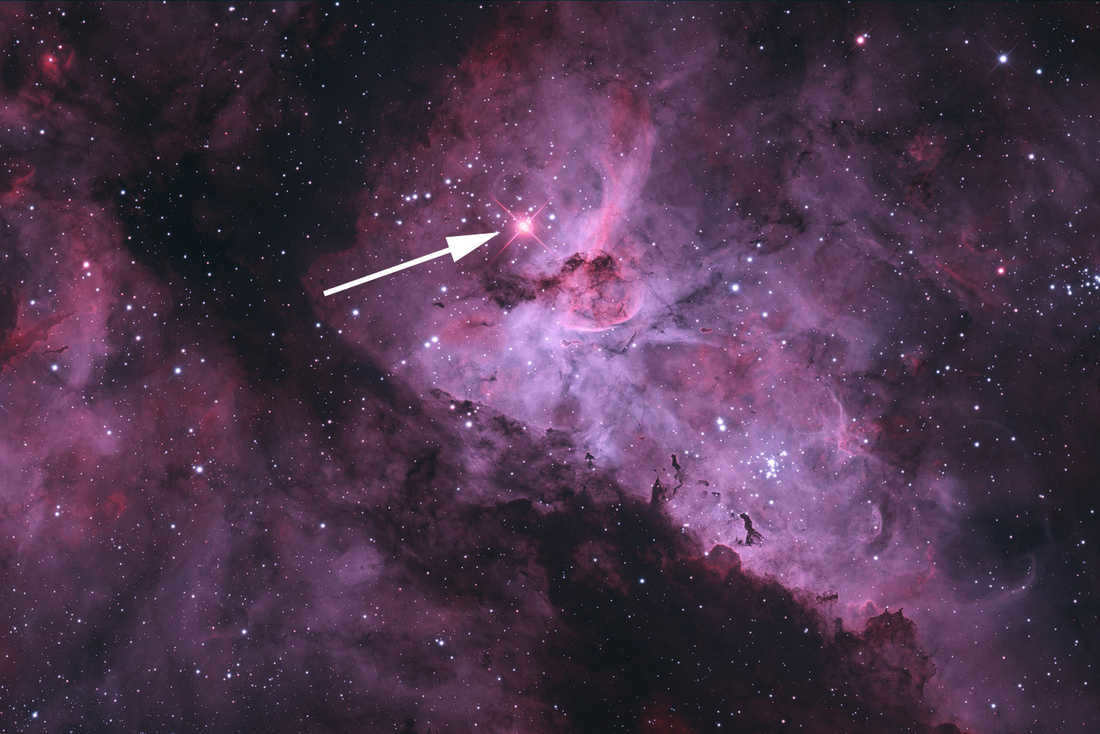
The star’s luminosity rose dramatically within a fortnight, reaching the same level of brightness as the most radiant celestial bodies in the nocturnal firmament. From 1843 to 1844, it surpassed all other stars in brilliance except for Sirius. Within a few years, Eta Kiel diminished in luminosity, eventually becoming visible only through a telescope.
A group of astronomers has successfully determined that this is an unsteady hypergiant with immense luminosity, making it an incredibly uncommon type of star. The estimated mass of these celestial objects is between 150 and 250 times that of our sun, which is near the theoretical upper limit. Despite their vast reserves of fuel, these stars have a short lifespan, typically only lasting a few million years. It is evident from the current condition of the Kiel star, which is displaying signs of aging, that its time is running out. In just a few tens of thousands of years, it will erupt into a brilliant supernova.
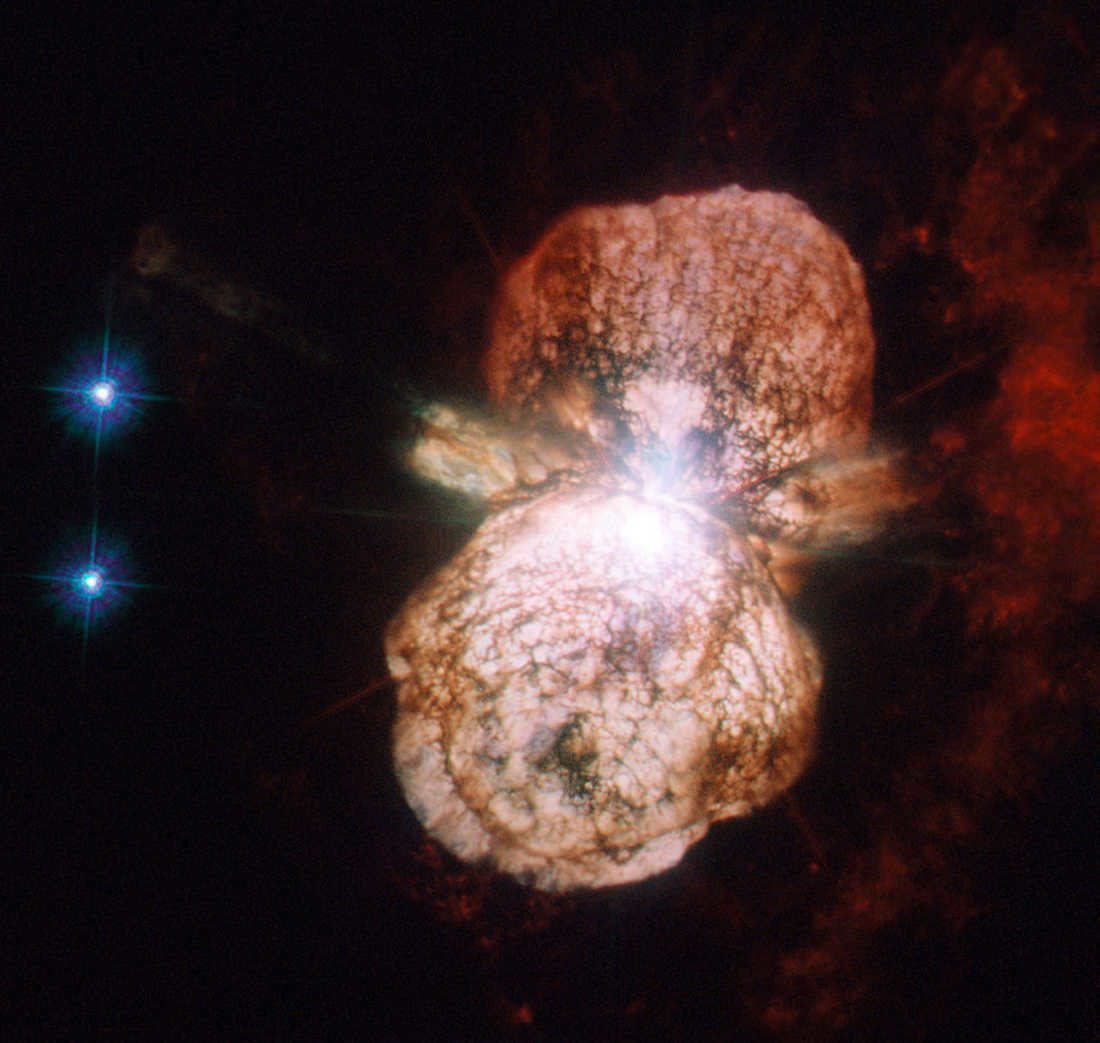
Incidentally, the sudden disappearance of the star can be attributed to the Great Eruption, which expelled a significant amount of matter into the surrounding space. This matter has now enveloped Eta Kila and is still absorbing its radiation. As the nebula gradually dissipates, the luminosity of the star is steadily increasing, making it visible to the naked eye once again.
Further reading:
Please note that the text and photos from Onliner.by cannot be reproduced without permission from the editorial team. Contact [email protected] for inquiries.
Many individuals who admire the celestial sky on a clear evening have a longing to capture the scene. Unfortunately, these endeavors are not always fruitful, particularly since an individual who is accustomed to taking photographs solely during the daytime with an abundance of light often lacks knowledge on how to approach shooting in seemingly unfavorable conditions. Nonetheless, obtaining a stunning nighttime shot with vibrant colors, easily distinguishable constellations, and a pale strip of the Milky Way stretching across the sky is simpler than it initially appears, and in this article, I will attempt to delve into the practical aspect of the matter when feasible. It is important to note that we are not discussing advanced astrophotography, but rather the everyday capturing of the starry sky within the context of landscape photography. The intricate capturing of deep space objects (galaxies, nebulae, quasars, etc.) necessitates very specific expertise and equipment, whereas anyone can enhance a nocturnal landscape with a general depiction of the Milky Way.
There are two types of starry sky photos. The first type represents the stars as individual points, similar to how we see them in real life. These photos are achieved by using relatively short shutter speeds, typically up to 30 seconds. In the second type, very long shutter speeds are used, sometimes lasting several hours. Alternatively, a series of short exposures can be combined using specialized software. Due to the Earth’s rotation, the stars create long luminous trails in the sky, wrapping around the Earth’s pole. These images have a unique appearance, but personally, I prefer the first type of photos because they look more realistic and artistic. Additionally, they are technically easier to obtain. Therefore, we will focus on capturing photos that depict stars as stationary points.
Equipment
Camera
In order to capture stunning night photos, it is essential to have a camera equipped with a large sensor and manual exposure settings. This means opting for a DSLR, mirrorless camera, or even an advanced compact camera. Using a camera with a small sensor, such as a soapbox camera, even with manual settings, would be ineffective as the stars would be overwhelmed by noise and become indistinguishable. It’s worth noting that using a cell phone for night photography would only serve the purpose of providing additional light during the shoot, rather than capturing high-quality images.
Mirrorless cameras are preferred over DSLR cameras due to their optical viewfinder. While the electronic viewfinder on some mirrorless cameras may become dim in low light conditions, the traditional optical viewfinder allows for composing shots even in starlight.
Lens
Opt for the widest and fastest lens available. A wide-angle lens will allow you to capture more of the sky and minimize the blurring of stars caused by the Earth’s rotation. Additionally, a fast lens is crucial in low light situations, as the ability to open the aperture wider will be highly valuable.
The ideal lens for stargazing is one that has a fixed focal length of 20-24mm (equivalent to 35mm) and an aperture of either f/1.4 or f/1.8. While a zoom lens with an aperture of f/2.8 is acceptable, it is not nearly as good. However, even if all you have is an 18-55mm kit zoom lens with a maximum aperture of f/3.5 in the wide-angle position, don’t be discouraged! It will still work just fine.
Personally, I’m not usually a fan of fisheye lenses, but if you know how to use them, they can be quite suitable for stargazing.
Tripod
Any tripod capable of bearing the weight of your camera is suitable.
Remote shutter release
A remote or cable shutter release is handy, although not essential. We will be employing extended shutter speeds, during which any potential vibration resulting from the shutter release will account for only a minuscule portion of the overall exposure duration and will have minimal to no impact on the final image’s sharpness.
Flashlight
To prevent accidents in complete darkness or avoid stepping on unpleasant surprises, such as cow dung, it is essential to have a flashlight. Moreover, a flashlight comes in handy for focusing on specific objects. Additionally, if the artistic purpose requires it, a flashlight can be used to highlight certain features of the landscape. The effectiveness of the flashlight is directly related to its power. The stronger the flashlight, the more effective it will be in providing illumination.
As you move further away from urban areas, the amount of light pollution from street lights decreases, allowing for a clearer view of the stars. Light pollution poses the biggest challenge when capturing photos of the night sky, as it often results in a brown or orange hue instead of the desired black. In essence, the more secluded the location you choose for photography, the better the results. It is recommended to be at least a few kilometers away from the nearest town or village with minimal street lighting, and even better if you can find a spot several tens of kilometers away from major cities. To gauge the level of light pollution in your vicinity, you may consider referring to the Blue Marble map.
By the way, moonlight is also effective in illuminating the night sky. Therefore, if your intention is to capture the beauty of the stars rather than the moonlit landscape (which is also remarkable in its own way), it is advisable to take photographs on moonless nights whenever possible.
Naturally, it is essential for the sky to be clear, so it is recommended to check the weather forecast beforehand to avoid unexpected rain showers. However, the presence of some wispy clouds in the sky can sometimes enhance the composition of a photo. In fact, even the ambient light from distant cities can be utilized creatively if it cannot be avoided.
Regarding the timing of the photoshoot, it is recommended to wait for at least two hours after sunset (this is applicable to the 54° north latitude, my current location). The later it gets, the more ideal it becomes (incidentally, in Belarus, astronomical midnight occurs around 1:00). The darkest nights, adorned with stars shining as brilliantly as precious gems, typically occur during the winter season. Unfortunately, it is lamentable that our winter weather is often characterized by cloudy skies, obscuring the stars from view. On the rare occasion of a cloudless winter night, one must endure the harsh frost that accompanies it.
Creating a Composition
When it comes to creating a composition, it’s important to have a clear understanding of what you’re looking at through the viewfinder. However, there are times when you might still notice something that catches your eye. In these situations, it’s often best to position the horizon line as low as possible. The ground may not be of significant artistic interest, but the starry sky, which is often the main focus, can be captivating. You can incorporate the Milky Way into the entire frame, from one corner to another, or you can search for familiar constellations, bright stars, and planets. For those who want to enhance their knowledge of astronomy, I recommend using Stellarium. Additionally, if there are individual clouds in the sky, you can use them as elements to structure your composition. Vertical frames can also be effective in this context.
If you desire, you have the option to brighten up the objects in the foreground using a flashlight, as long as you are not concerned that they may divert the viewer’s focus away from the captivating starry sky. Typically, this approach is warranted when the night is not excessively dim (due to backlighting or moonlight) and the sky lacks sufficient expressiveness to serve as the primary focal point of the composition.
Adjusting camera preferences
Next, we will discuss some technical suggestions.
Which format to use: RAW or JPEG?
I would like to direct readers to the relevant article. Personally, I believe that shooting in RAW is the better option for night photography as it often requires significant post-processing. However, shooting in JPEG can also yield satisfactory results, although with less control over the final output.
Concentrating
If you direct your camera towards the nocturnal heavens and attempt to utilize autofocus, chances are you will not succeed. The stars typically lack sufficient brightness for the autofocus sensors to detect them (although it may work with planets). Traditional manual focusing is also improbable, as individual stars are virtually invisible in the viewfinder when using wide-angle optics. Consequently, the lens must be coerced to focus at infinity for photography. How can this be achieved?
Previously, older manual lenses offered the ability to aim at infinity without any visual guidance by simply rotating the focusing ring until it reached its maximum point. However, modern autofocus lenses no longer have focus stops and their focusing distance scale is not very accurate. While it is still possible to use this scale (with the help of a flashlight), it is necessary to calibrate it beforehand in order to determine the corresponding values for true photographic infinity. During daylight hours, you can allow the autofocus to focus on a distant object near the horizon and then take note of the value on the scale that corresponds to this point. This information can then be used when the autofocus is unable to function effectively.
Exposure
The exposure meter is not useful in low light conditions, so it is best to use manual mode and adjust the exposure by feel. Estimating the correct exposure can be challenging for several reasons. Firstly, the camera screen may appear bright in the dark, causing underexposed pictures to look normal and normal pictures to appear overexposed. Secondly, relying on the available light is not ideal in this situation because stars are too bright. If you try to avoid overexposing the stars, the rest of the image will be too dark. As a result, both shadows and highlights will fall outside the camera’s dynamic range. Lastly, long shutter speeds make it time-consuming to experiment with exposure settings.
Below, I will attempt to demonstrate how to achieve a relatively accurate exposure without relying on an exposure meter or engaging in tedious selection.
Aperture
Expand the aperture to its maximum, meaning select the lowest available aperture setting for your lens. At this moment, every photon is of utmost importance, and this is precisely the scenario where you can sacrifice some sharpness in exchange for a less noisy image.
Shutter speed
When the shutter is open for a longer period of time, more light will reach the sensor, which is a good thing. However, this can also result in the stars in the image appearing blurred due to the Earth’s rotation, which is not ideal.
To address this issue, photographers often follow the “600 rule”. According to this rule, you can determine the maximum allowable shutter speed in seconds by dividing the number 600 by the equivalent focal length of the lens in millimeters. For example, if you have a 20mm lens, the shutter speed would be 600 ÷ 20, which equals 30 seconds. For a longer 35mm lens, a slower shutter speed would be required: 600 ÷ 35 = 17. Since not all cameras have shutter speeds that go up to 17 seconds, the result can be rounded up to 15 seconds.
However, based on my personal experience, I have found that utilizing shutter speeds that are one and a half times longer than the 600 rule (which can be referred to as the “900 rule”) can yield satisfactory results. Although the stars may appear slightly blurred when viewed at 100% magnification near the celestial equator, this blurring is minimal and can be easily disregarded.
For individuals who are new to night photography, I would suggest an even simpler and more flexible approach: if you are utilizing a wide-angle lens (or a standard zoom lens set to a wide-angle position), set the shutter speed to 30 seconds and do not be concerned. This is especially true since many cameras have a maximum shutter speed of 30 seconds in standard modes, making it unnecessary to select a slower shutter speed.
ISO
If you followed my recommendation and adjusted your shutter speed to 30s and opened the aperture completely, you should set your ISO sensitivity to the specified value based on the aperture of your lens:
| Aperture | ISO |
| f/1.4 | 800 |
| f/1.8 | 1250 |
| f/2 | 1600 |
| f/2.8 | 3200 |
| f/3.5 | 5000 |
| f/4 | 6400 |
The values provided in the table are meant to serve as initial reference points, and can be adjusted as needed.
If your camera has the capability, you should consider enabling Long exposure noise reduction. However, keep in mind that this feature will add an extra half minute to the time it takes for each exposure, as the camera will take a test shot with the shutter closed. It’s worth the wait though, as it can greatly improve the image quality, even if you’re shooting at high ISO settings and expect some noise.
When shooting in RAW format, white balance and image style settings are not crucial, as you can adjust them during post-processing. However, if you’re shooting in JPEG or want your pictures to look good straight out of the camera, I have a few more recommendations for you.
Adjusting White Balance for Starry Skies
When shooting starry skies, relying on automatic white balance is not recommended, unless you intentionally want to create a murky grayish-brownish-raspberry tint in the sky. Instead, there are other options to consider.
One option is to set the white balance for incandescent light bulbs, such as Tungsten or Incandescent, which typically have a color temperature of around 3000 K. However, this may result in a picture that appears too cold.
Another option is to use presets specifically designed for fluorescent lamps. These presets include White fluorescent (3700 K) or Cool-white fluorescent (4200 K), which can provide more accurate colors for starry skies.
If your camera allows manual adjustment of color temperature, you can start with a setting of 4000 K and slightly shift the Tint towards Magenta. From there, you can fine-tune the values through experimentation until you achieve the desired result.
Image style
For capturing starry skies, the optimal choice is Vivid or a similar style that enhances colors and contrast, and you can further intensify the color saturation by adjusting the Saturation parameter. Unlike daytime landscapes, don’t hesitate to embrace unrealistically vibrant colors for astrophotography, as the scene will appear incredibly unique and the additional colors will only enhance its beauty.





